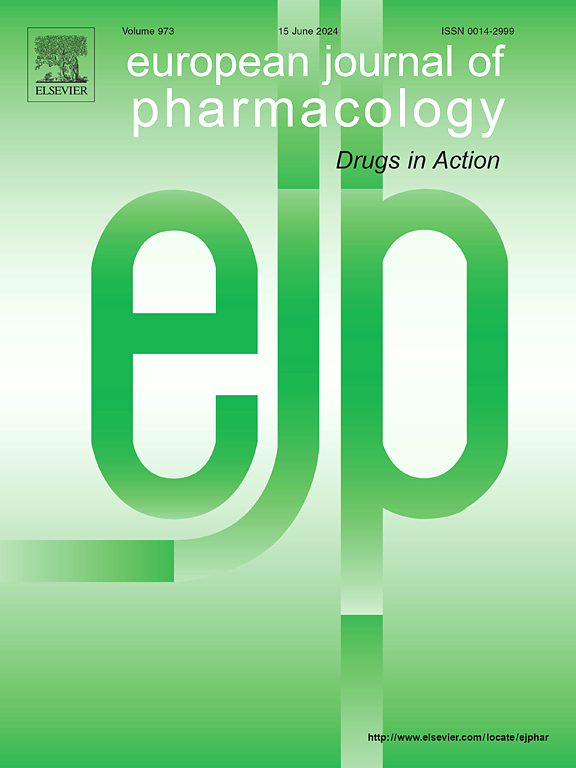甘氨酸受体α 3激动剂的荧光分析方法
IF 4.2
3区 医学
Q1 PHARMACOLOGY & PHARMACY
引用次数: 0
摘要
甘氨酸是一种重要的神经递质,在中枢神经系统(CNS)中起着复杂的作用。它作为一种抑制性神经递质通过与配体门控氯通道相互作用。甘氨酸通过与甘氨酸受体α1 (Glyr α1)和3 (Glyr α3)亚基相互作用,在疼痛和瘙痒的传递中起着至关重要的作用。针对中枢神经系统中的甘氨酸能神经传递,特别是脊髓,可以为镇痛和/或刺激性药物的发现提供有益的策略。目前,针对甘氨酸受体的新型药理激动剂和调节剂的研究仍处于早期阶段。在本研究中,我们设计了两种不同的载体来表达人异五聚体GlyR α3β。我们测试了不同的化学转染方案,并在急性转染细胞和接受抗生素选择的细胞中进行了荧光终点测量。我们使用膜片钳研究了载体表达细胞的电生理特性,进一步验证了我们的发现。结果表明,急性载体转染细胞和载体转染细胞经受抗生素选择工作同样良好,在基于荧光的测量。然而,在单细胞测量中,如膜片钳,急性转染的细胞表现更好。结果进一步表明,逆转[Cl-]的平衡电位可以增强FluoVolt™膜电位染料的荧光响应,可用于膜片钳测量。该研究建立了一种简单、经济的方法,利用表达GlyR α3β的载体进行化学转染,筛选细胞培养物中的化合物,这可能有助于开发下一代非阿片类镇痛药。本文章由计算机程序翻译,如有差异,请以英文原文为准。

Fluorescence-based method for analysis of glycine receptor alpha 3 agonists
Glycine, a key neurotransmitter, plays a complex role in the central nervous system (CNS). It acts as an inhibitory neurotransmitter by interacting with ligand-gated chloride channels. Glycine plays a crucial role in pain and itch transmission through its interactions with the glycine receptor alpha 1 (Glyr α1) and 3 (Glyr α3) subunits. Targeting glycinergic neurotransmission in the CNS, particularly the spinal cord, could provide a beneficial strategy for analgesic and/or abirritant drug discovery. Currently, the search for novel pharmacological agonists and modulators against glycine receptors is still in its early stages.
In this study, we designed two different vectors to express the human hetero-pentameric GlyR α3β. We tested different chemical transfection protocols and performed fluorescence endpoint measurements in acutely transfected cells and cells that underwent antibiotic selection. We further validated our findings by studying the electrophysiological properties of the vector-expressing cells using patch clamp.
The results demonstrate that acutely vector-transfected cells and vector-transfected cells subjected to antibiotic selection work equally well during fluorescence-based measurements. However, in single-cell measurements such as patch clamp, acutely transfected cells perform better. The results further show that reversing the equilibrium potential of [Cl-] can enhance the fluorescence response from the FluoVolt™ membrane potential dye, which can be used during patch clamp measurements. This establishes a simple and cost-effective method to screen for compounds in cell cultures using chemical transfection with a vector expressing GlyR α3β, which could aid in developing the next generation of non-opioid analgesic.
求助全文
通过发布文献求助,成功后即可免费获取论文全文。
去求助
来源期刊
CiteScore
9.00
自引率
0.00%
发文量
572
审稿时长
34 days
期刊介绍:
The European Journal of Pharmacology publishes research papers covering all aspects of experimental pharmacology with focus on the mechanism of action of structurally identified compounds affecting biological systems.
The scope includes:
Behavioural pharmacology
Neuropharmacology and analgesia
Cardiovascular pharmacology
Pulmonary, gastrointestinal and urogenital pharmacology
Endocrine pharmacology
Immunopharmacology and inflammation
Molecular and cellular pharmacology
Regenerative pharmacology
Biologicals and biotherapeutics
Translational pharmacology
Nutriceutical pharmacology.

 求助内容:
求助内容: 应助结果提醒方式:
应助结果提醒方式:


